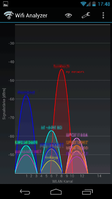1) a ) I tested again, ensured that the Pandora is the only device on my wireless network.
The results were bad as usual. 30-60 KB/s, either staying that disappointing, or getting to a stall somewhen.
b ) Btw, the WiFi channel distribution in my urban neighborhood:
- ch1 (3 networks, -90 - -65)
- ch6 (4 networks, -95 - -75)
- ch8 (1, only my network, -45, my amateurish thought: "Using the gap" within channel 6 and 11, preferring "lighter collisions" with 8 networks' partially overlapping frequencies, instead of heavier collisions with less networks (3-4) but fully overlapping frequencies)
- ch11 (4 networks, -92 - -82)

2) Meanwhile my http://webserver-
wired-100mbit.local/bigfile -O /dev/null gives me steady 2.4 MB/s.
d )
wget http://webserver-on-same-wireless-54mbit-network.local/bigfile -O /dev/null gives me stable ~1 MB/s.
3) Power usage of OpenPandora's internal WiFi versus USB WiFi adpapter:
- While active transmissions, the internal WiFi (966 mW) and USB WiFi (900 mW) consume about the same power.
- In idle mode the internal WiFi (30 mW) consumes considerably less, as for external WiFi, both the idle USB-host (160 mW) and the idle USB-WiFi (240 mW) consume more, giving a total of 400 mW for idle USB WiFi.
- While idle operation on the USB WiFi, occasionally there is an increase of 300 mW lasting only very shortly (data link layer, I guess).
Note: How did I get these numbers? I ran
sysinfo. Assessed my Pandora's base consumption — 700 mW from using: CPU @ 800 Mhz OPP5, BT/USB/WiFi all off, screen on low brightness, power-LED with brightness 32/256, 2 SDs inside, XFCE window manager, Terminal window (for wget tests), sysinfo showing power tab) — and then created the other situations (enabling internal-WiFi/USB-host, plugging adapter in/out, running WiFi idle/active), and calculated the difference to the previous situation, and considered it as the consumption for this device or activity.
4) Practically, the issue is solved for me. But for my hacker, tinkering & community morale, it is yet not solved! Our current status:
- I think a mis-calibration is unlikely to be the root for the problem, as alternative calibration profile loading from users porg, klapse & Galaxis brought no significant improvements. Anyone still believing, the issue could be here?
- Power problems of the Pandora (hi-speed WiFi drains quite some battery, almost 1W), giving the WiFi chip not enough power, seem logical at first, but not so much at the second glance, as USB WiFi drains about the same power (900 mW) but works at high speed without problems! Could only be true if the power line to the WiFi chip delivers less current (I remember something about wrong chosen resistors in very early Pandoras…) than the one going to the USB-host-port. Ideas?
- If people experience good network speeds with the lid closed, they could misinterpret the WiFi issue as a chip-power-shortage issue (thought: "LCD backlight drains a lot of power, which if off, is then available to the "power-hungry" WiFi chip), which in fact could be rather an interference issue — LCD signals interfering with the mini-PCB, or the connection cable between the main Pandora PCB and the mini PCB.
- More realistic to me seems a mix of an antenna/interference issue (loose contact, radio-blocking metal tape, interference with the LCD) in combination with the power-management to cut down aggressively, due to the bad reception, being the fault of the antenna/interference issues, and possibly slightly responsible: an unoptimized WiFi chip calibration.
These are my last guesses. I am running out of ideas. Any thoughts?



